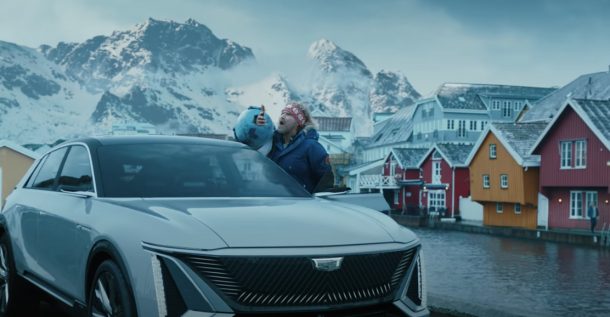GM Hypes Norway's EV Leadership
Actor Will Farrell describes Norway’s EV leadership in one of the more amusing Super Bowl commercials, and how General Motors is looking to change all that here at home.
According to a Forbes.com article, in March 2019 almost 60 percent of new cars sold in Norway were electric vehicles (EV), in a country bent on stopping the sale of fossil-fueled vehicles by 2025. While unit sales of EVs are higher in China and the U.S., the percentage of EVs in Norway is higher than anywhere else in the world.
The reasons are numerous, not the least of which is Norway’s domestic hydroelectric production. With almost all their electricity coming from a renewable source, it’s easier and infinitely less expensive than it would be for a conversion to occur here. Add the financial incentives and charging infrastructure the Norwegian government has put in place, and it’s a near-perfect scenario you likely won’t see happening in the U.S. anytime soon.
Lowered road taxes, removal of toll road and ferry charges, and free parking were among the benefits of EV ownership in Norway as far back as 1990. A 25 percent sales tax on new EVs was lifted in 2001, and you could drive your EV in the bus lane starting in 2005. While the government started building charging stations, now private enterprise has taken over, and there’s even overseas interest in their construction and operation. All this for a country of 5 million Norwegians, or about the size of South Carolina, our 23rd most populated state.
Working with such a small base, it’s understandable why the government reached its goal of 50,000 zero-emission vehicles in operation three years earlier than they had anticipated. The used-car market in Norway remains gas-powered, so incentives for EV ownership are seen as nothing more than tax cuts for the wealthy. Many Norwegians argue it’s doing nothing to take gas-fueled vehicles off the road, but what would you expect in a country obsessed with electric-powered technology, in aircraft, boats, and other sectors?
You only need to look at Norway’s neighbor, Sweden, to see the folly in attempting to replicate what was done there. In 2010, Sweden had more new EV registrations than Norway. Today, Norway’s EV numbers are ten times that of Sweden. Why? The demand for electricity in cities increased faster than the availability of kW hours, especially in Stockholm, the capital. Just as they are recommending here, power companies and EV advocacy groups want to incentivize EV owners to charge only during off-peak hours so as not to overtax our power grid. Fascinating, no?
[Images: General Motors]
With a father who owned a dealership, I literally grew up in the business. After college, I worked for GM, Nissan and Mazda, writing articles for automotive enthusiast magazines as a side gig. I discovered you could make a living selling ad space at Four Wheeler magazine, before I moved on to selling TV for the National Hot Rod Association. After that, I started Roadhouse, a marketing, advertising and PR firm dedicated to the automotive, outdoor/apparel, and entertainment industries. Through the years, I continued writing, shooting, and editing. It keep things interesting.
More by Jason R. Sakurai
Latest Car Reviews
Read moreLatest Product Reviews
Read moreRecent Comments
- Slavuta Motor Trend"Although the interior appears more upscale, sit in it a while and you notice the grainy plastics and conventional design. The doors sound tinny, the small strip of buttons in the center stack flexes, and the rear seats are on the firm side (but we dig the ability to recline). Most frustrating were the repeated Apple CarPlay glitches that seemed to slow down the apps running through it."
- Brandon I would vote for my 23 Escape ST-Line with the 2.0L turbo and a normal 8 speed transmission instead of CVT. 250 HP, I average 28 MPG and get much higher on trips and get a nice 13" sync4 touchscreen. It leaves these 2 in my dust literally
- JLGOLDEN When this and Hornet were revealed, I expected BOTH to quickly become best-sellers for their brands. They look great, and seem like interesting and fun alternatives in a crowded market. Alas, ambitious pricing is a bridge too far...
- Zerofoo Modifications are funny things. I like the smoked side marker look - however having seen too many cars with butchered wire harnesses, I don't buy cars with ANY modifications. Pro-tip - put the car back to stock before you try and sell it.
- JLGOLDEN I disagree with the author's comment on the current Murano's "annoying CVT". Murano's CVT does not fake shifts like some CVTs attempt, therefore does not cause shift shock or driveline harshness while fumbling between set ratios. Murano's CVT feels genuinely smooth and lets the (great-sounding V6) engine sing and zing along pleasantly.






































Comments
Join the conversation
Barron's Article today "Electric Vehicles Were a Nonstarter—Until Tesla Came Along".
The idea of a oil rich country claiming to be green is a laugh. The oil they are selling and funding the EV program with will be used by others and Norway will be affected by it. And using government power to force a solution on its population goes against the grain for most. Norway is a very small country (5 mil), and what ever it does is not a model for the rest of the world. One only has to look at the mental illness rate and suicide rate to wonder what is going on.